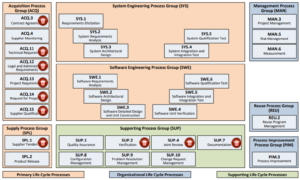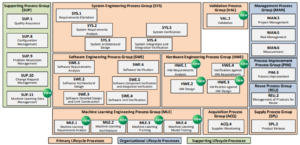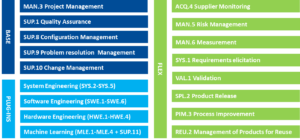A new version is here
The Automotive SPICE® (A-SPICE) framework has established itself as a critical process capability model within the automotive industry. It provides best practices for structured system development.
A-SPICE has gained widespread popularity among Original Equipment Manufacturers (OEMs) and Tier 1 suppliers, who often rely on A-SPICE assessments to evaluate the capabilities of their suppliers.
Version 4.0 of A-SPICE was released late 2023. In short, the new version includes clean up, removing unused areas and harmonizing terms, and strengthening of the plug-in concept, adding two new concepts “hardware” and machine learning” as complement to the existing software process group.
Key changes
- Slimline through of remove process areas that were not used
- Strengthen the plug-in concept with the addition of hardware and machine learning (HWE / MLE) that can replace or complement software (SWE).
- Detailed improvement
- Some model adjustments
- Slimline generic practices on CL3
- Improve language
- Simply some aspect
Removal of process areas
Ten process areas have been removed. They belong to the categories of acquisition (six process areas), support (three process areas) and supply (one process area). Theses process areas were seldom used so these changes that at first appear to be large, in reality is rather small.

Figure 1: A-SPICE version 3.1 with the ten removed process areas market
Plug in concept
To make the A-SPICE model more relevant for the industry three new process groups with in total ten new process areas have been added. The new process groups are:
- HWE (hardware engineering).The new version adds four processes for hardware development (HWE.1 – HWE.4), which are key for development of mechatronic systems. Even though the software part is growing, hardware plays a significant part of automotive development
- MLE (machine learning engineering). A-SPICE 4.0 includes four processes (MLE.1 – MLE.4) related to machine learning engineering. These processes focus on developing and integrating AI and data-driven technologies into automotive systems.
In addition to these four process areas another process area related to machine learning data management has been added to the support category (SUP.11). This process addresses the need for effective data handling throughout the machine learning lifecycle, from collection and storage to processing and analysis. - VAL (validation process). A new validation process (VAL.1) has been introduced to ensure that the overall system meets its requirements and performs as expected. This process is close the loop to stakeholder requirements and focus to secure successful “intended use” .

Figure 2: A-SPICE version 4.0 with the added ten process areas market
Scoping A-SPICE 4.0
With this new version scoping has become more intriguing. Before there was basic and extended scope and the only process area that was possible to de-select was ACQ.4. In version 4 there are three different scope types.
- Base: The core or the base of A-SPICE 4.0 are five process areas that always shall be applied
- Plug-in: minimum one of the plug ins must be selected: SYS/SWE/HWE/MLE
- Flex: the flex process areas are optional and can be added as appropriate

Figure 3: A-SPICE version 4.0 with the different process areas marked with scope type
Each organization need to analyse their scope. For A-SPICE assessments the sponsor defines the scope. BASE is always mandatory, then minimum one of the PLUG INS must be selected and finally the FLEX process areas shall be applied as relevant. ACQ.4 supplier monitoring and SPL.2 Product release will likely be the most applied process areas followed by MAN.5 Risk management.
Examples:
- Former VDA scope: BASE + SYS + SWE
- Electronic development: BASE + HWE
- Development of software for road sign interpretation: BASE + SWE + MLE
- Software development: BASE + SWE
In all cases FLEX additions might be relevant.

Figure 4: The three types of categories for scoping A-SPICE process areas
Detailed Changes
The detailed changes include many aspects like: model adjustments, improved language for increased understanding and slim lining some base/generic practices. Some changes will have significant impact on organizations working to meet A-SPICE expectations.
- Strategies moved from CL1 to be applicable for all process at CL2. In version 3.1 all verification process areas and the supportive process areas expect that a strategy directs the process area. This was often over interpretated and CL2 expectations was brought into CL1. The base practice with “strategy” has now been removed and instead GP2.1.1: “Identify the objectives …” is replaced by “Identify the objectives and define a strategy for the performance of the process”. As a consequence, all process areas at CL2 are expected to have a strategy. As a result, CL1 becomes more of doing and CL2 more repeatable!
- Evaluation of architectural alternatives (SYS.3.BP5, SWE.2.BP6) has been simplified to that “chosen architecture must be justified”. In many situations there is only one architecture alternative, based on legacy or customer requirements, which made the old practice less meaningful.
- Evaluate software detailed design (SWE.3.BP4) has been removed. It is covered by GP2.2.
- No specific base practice for “Verification criteria” (SYS.2.BP5, SWE.1.BP5) But it is instead included (or hidden) in “defined characteristics for requirements” (SYS.2.BP1, SWE.1.BP1) which in v4.0 include verification criteria.
- SW integration testing (SWE.5), now include both integration testing as well as component testing.
- Traceability and consistency merged/combined. BPs for traceability and consistency have been merged (affects all engineering and verification processes). Focus is to ensure consistency; traceability is one enabler but not mandatory to review or document
- Restructuring Generic Practices (slim lining)
-
- GP2.1.3 + GP2.1.4 merged into (monitor and adjust)
- GP3.1.1+ GP3.1.2+ GP3.1.3 (roles/responsibilities/authorities) merged into “maintain standard process”
- GP3.2.2+ GP3.2.3+ GP3.2.4 (Human resource) merged into “ensure required competencies for the defined roles”
- GP3.2.4 (information)+ GP3.2.5 merged into “ensure required resources to support the performance”
In summary 4 generic practices are removed, which means that if you assess 15 process areas it becomes 60 generic practices less.
- Terminology changes to support more consistent understanding and application. E.g:
-
- “information items” replace “work products”, to describe the required result of a process. Today an output from activities in a specific process reside as information in a tool rather than a specific document or work product.
- “verification” instead of “testing”, the previous “test specification” is now “verification measures”, to be valid for SYS/SWE/HWE
- Removing “item” with “units” and “elements” to align with other standards
Concluding words
In summary the main changes are related to the plug-in concept with the addition of new process group and process areas.
But for companies with VDA scope, the main changes will be the detailed changes since they will not be affected by the removal/addition of process areas.
Out of the different detailed changes the “Strategy to CL2” and “added component test” are probably the main changes to consider.
In addition, there are change in the guidelines for how to conduct A-SPICE assessments. But this relevant for assessors is maybe a topic for afuture article.
